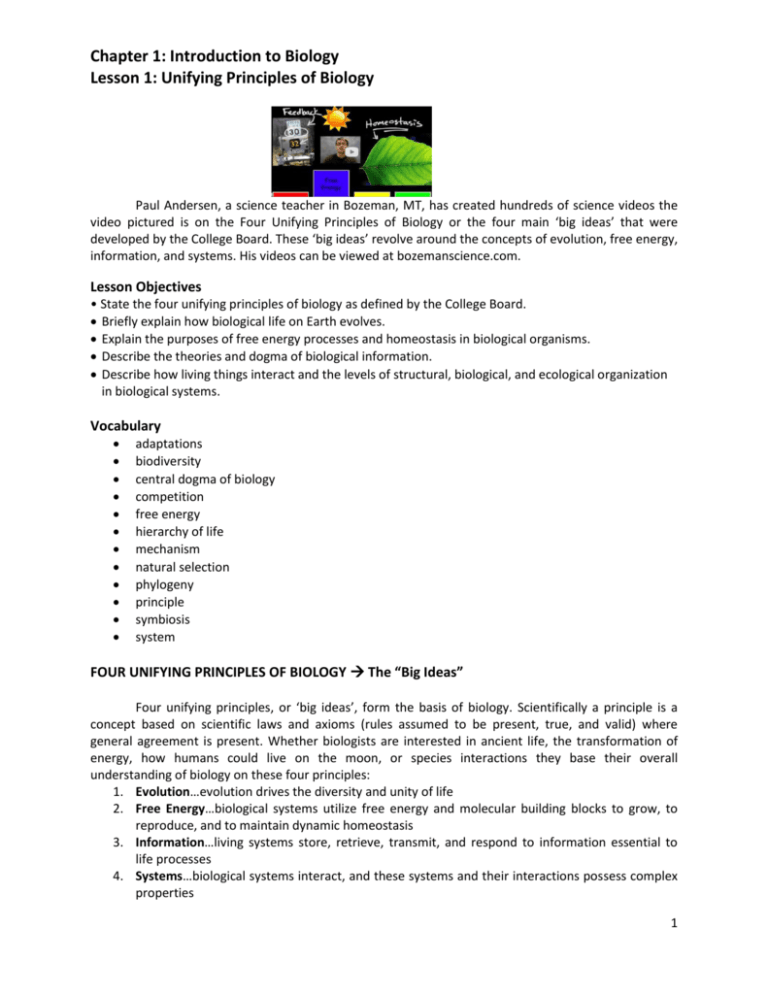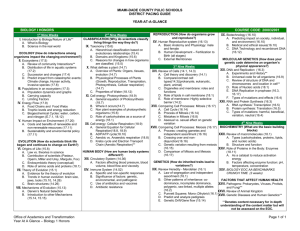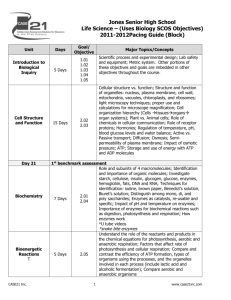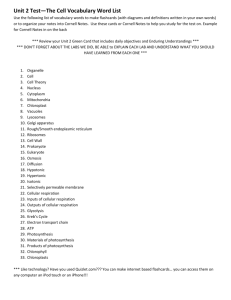Chapter 1: Introduction to Biology Lesson 1: Unifying Principles of
advertisement

Chapter 1: Introduction to Biology Lesson 1: Unifying Principles of Biology Paul Andersen, a science teacher in Bozeman, MT, has created hundreds of science videos the video pictured is on the Four Unifying Principles of Biology or the four main ‘big ideas’ that were developed by the College Board. These ‘big ideas’ revolve around the concepts of evolution, free energy, information, and systems. His videos can be viewed at bozemanscience . Lesson Objectives • State the four unifying principles of biology as defined by the College Board. Briefly explain how biological life on Earth evolves. Explain the purposes of free energy processes and homeostasis in biological organisms. Describe the theories and dogma of biological information. Describe how living things interact and the levels of structural, biological, and ecological organization in biological systems. Vocabulary adaptations biodiversity central dogma of biology competition free energy hierarchy of life mechanism natural selection phylogeny principle symbiosis system FOUR UNIFYING PRINCIPLES OF BIOLOGY The “Big Ideas” Four unifying principles, r ‘big ideas’, form the basis of biology. Scientifically a principle is a concept based on scientific laws and axioms (rules assumed to be present, true, and valid) where general agreement is present. Whether biologists are interested in ancient life, the transformation of energy, how humans could live on the moon, or species interactions they base their overall understanding of biology on these four principles: 1. Evolution…ev luti n drives the diversity and unity f life 2. Free Energy…bi l gi al syste s utilize free energy and le ular building blocks to grow, to reproduce, and to maintain dynamic homeostasis 3. Information…living syste s st re, retrieve, trans it, and resp nd t inf r ati n essential t life processes 4. Systems…bi l gi al syste s intera t, and these syste s and their intera ti ns p ssess complex properties 1 Evolution All life on Earth was descended from one common ancestor according to the theory of evolution which was established by Charles Darwin as a viable scientific model in 1859. Darwin, in his book Origin of Species theorized that species and breeds developed through the processes of natural selection and artificial selection or selective breeding, with the main driving force of evolution being natural selection. In natural selection, when living things produce offspring with more favorable characteristics to survive in the environment, these surviving offspring are then able to reproduce and pass these favorable characteristics on to the next generation. Over many generations, this can lead to major changes (variations) in the characteristics of a species. The theory of evolution today explains how species are changing and how modern species have descended from ancient life forms that no longer exist on Earth. Four other factors in addition to natural selection are known to contribute to macroevolution, or the process of existing species forming populations of new species. These factors are small populations, non-random mating, genetic mutations, and immigration and emigration. As populations of species evolve, they generally become better suited to their environment. This is because they evolve adaptations, which are characteristics that help species survive and reproduce in a given environment. The evolutionary history of the species—which describes the characteristics of the various species from which it descended—together with its genealogical relationship to every other species is known as its phylogeny. The phylogenetic tree of life can be seen in Figure 1.6. Widely varied approaches to biology generate information about phylogeny. These include the comparisons of DNA sequences conducted within molecular biology and comparisons of fossils or other records of ancient organisms in paleontology. Biologists organize and analyze evolutionary relationships through various methods, including phylogenetics and cladistics. Figure 1.6 A phylogenetic tree based on rRNA genes. Today, scientists accept the theory of evolution of life on Earth. There is too much evidence supporting evolution to doubt it. For instance, biologists generally regard the universality and ubiquity of the genetic code as definitive evidence in favor of the theory of universal common descent for all living organisms. However, evolution is still questioned by some people. Often, people who disagree with the theory of evolution do not really understand it. For example, some people think that the theory of evolution explains how life on Earth first began. In fact, the theory explains only how life changed after it first appeared. Some people think the theory of evolution means that humans evolved from modern apes. In fact, humans and modern apes have a common ancestor that lived several million years ago. These and other misconceptions about evolution contribute to the controversy that still surrounds this fundamental unifying principle of biology. 2 Free Energy Biological life processes occur through the gathering, storage, and manipulation of free energy. The initial source of free energy for biological life processes is photons (particles of light or other electromagnetic radiation) harnessed from sunlight. There are exceptions, such as some bacteria which obtain energy from sources other than sunlight. Free energy is used by living organisms through a chain of coupled reactions or processes which pass free energy from one form to another. For example, photosynthetic organisms harness free energy from sunlight for the production of glucose, which is later used in cellular respiration for the production of ATP (adenosine triphosphate). ATP is one of the most important biological molecules that stores free energy in a form that is easily accessible for use by living cells. ATP is a high-energy molecule which releases energy when it is broken down into ADP (adenosine diphosphate) and inorganic phosphate (Pi). Another important storage mechanism of free energy used by living cells is the protonmotive force (pmf). Protonmotive force is the electrochemical gradient of H+ ions across a biological membrane. You will learn about these concepts when we study bioenergetics. Bioenergetics is sometimes referred to as biological thermodynamics and can generally be thought of as the study of energy transformations in biological sciences. The survival of a living organism depends on the continuous input of energy and the maintenance of stable internal conditions. This is why understanding free energy and the processes that harness and store it is important to the study of biology. So how exactly do cells harness free energy? Let’s briefly exa ine h w photosynthetic organisms harness energy from the photons in sunlight. The reactions which allow the photosynthetic process to occur are endergonic reactions, reactions that require energy in order to proceed (the sun provides this energy). Plants use the sun’s energy, carbon dioxide in the atmosphere, and water to make sugar (glucose) and oxygen through the process of photosynthesis (see Figure 1.7 below). The sugar made by plants is a complex organic (carbon-rich) compound which stores free energy to be used by both plants and other organisms. As complex organic compounds are broken down or built up through metabolic processes in organisms, energy is released or stored. Figure 1.7 The process of photosynthesis requires the input of sunlight, carbon dioxide, and water in order to produce oxygen and glucose. 3 Organisms that do not photosynthesize obtain glucose through consumption. They are able to use glucose as a source of energy by breaking down the chemical bonds in glucose through metabolic processes, called cellular respiration, releasing their stored energy and a small amount of heat. During cellular respiration, glucose is broken down into carbon dioxide and water and the energy that is released is used to make another chemical compound called ATP, adenosine triphosphate. A diagram of how this process occurs in humans can be seen in Figure 1.8. The reactions which allow the cellular respiration process to occur are exergonic reactions; energy is released as a result of the reaction. Figure 1.8 The process of cellular respiration in humans. In summation, photosynthesis and cellular respiration are coupled processes that pass free energy from one form to another in order to do work or to make energy available for other processes. Plants use sunlight to make sugar (stored energy) through photosynthesis, plants and other organisms break down the sugar (release energy) through cellular respiration to make another chemical, ATP. ATP stores free energy in a form that is most easily used by living cells. The reactants of photosynthesis are carbon dioxide and water and its products are oxygen and glucose. The reactants of cellular respiration are oxygen and glucose and its products are carbon dioxide and water. Photosynthesis and cellular respiration are related as the products of one become the reactants for the other. In fact, cellular respiration and photosynthesis are dependent on one another. ATP is broken down by cells when they need free energy to perform necessary life processes and for homeostasis, the maintenance of stable internal conditions. Homeostatic mechanisms regulate internal conditions such as pH levels, temperature, and fluid levels through feedback mechanisms found in the certain organ systems. Mechanisms are the combination of components and processes that serve a common function. The energy needed for homeostatic processes comes from harnessed free energy. For example, in humans the nervous system helps to regulate body temperature rises through nerve impulses that cause sweat glands to release more sweat, which cools the body as it evaporates, the homeostatic feedback mechanisms that make this occur can be reviewed in Figure 1.9. A quick overview of homeostasis can be viewed at http://www.youtube.com/watch?v=DFyt7FJn-UM. 4 Figure 1.9 The nervous system sets homeostatic feedback mechanisms into action to maintain a stable internal body temperature in humans. Information Biological information that flows from one living organism to another, from one generation to the next during cell division is stored in a molecule called deoxyribonucleic acid (DNA). DNA contains the blueprint of all biological information needed by living organisms to survive, reproduce, and carry out life processes. DNA can store and transmit hereditary information, replicate, synthesize proteins, and direct cell functions. The storage and transmission of hereditary information will be discussed in later chapters when we explore genetics. Genetics was first explored in the mid-1800s by Gregor Mendel, who is sometimes alled the ‘Father f Geneti s’ Today genetics is studied on a molecular level which examines the structure and function of chromosomes and genes. A chromosome is a structure made up of DNA. A gene is a segment of DNA on a chromosome that controls a particular hereditary trait. In order for hereditary information to be transferred from one living organism to another and from one generation to the next DNA replicates or copies itself each time a living rganis ’s ells divide. You can view a McGraw-Hill animation of DNA replication at the following link: https://highered.mcgrawhill.com/sites/0072507470/student_view0/chapter3/animation__dna_replication__quiz_1_.html The synthesis of proteins that work to direct cellular functions occurs through the processes of transcription (making a copy of) and translation (reading) of the DNA molecule. The flow of how the information needed to synthesize proteins is transcribed and translated f ll ws the ‘ entral d g a f bi l gy’ The ‘ entral d g a f bi l gy’ si ply states that DNA is trans ribed t RNA (rib nu lei a id) and RNA is translated into proteins by the cell. It is scientific symbolized as: DNA RNA Proteins. To see how this happens, click on the animation titled Journey into DNA at the link: http://spice.duit.uwa.edu.au/samples/ast0807/. Systems Biological organization, or the hierarchy of life (see Table 1.1), is the arrangement of biology structures and systems that encompass all living organisms. Traditionally the hierarchy of life extends from biological to ecological levels of organization from atoms to the biosphere. Each level classified above another level represents an increase in organizational complexity, with each level being primarily composed of the previous levels basic unit. Systems in biology are a set of interacting or interdependent components that form an integrated whole. 5 The biological arrangement of organizational levels provides the fundamental basis for areas of scientific research. Areas of research have focused upon how the interactions of biological systems create genetic biodiversity mainly through evolution and the interdependence of living organisms establishes symbiotic and competitive relationships. Table 1.1: The Hierarchy of Life. The simple standard biological and ecological organization scheme, from the lowest level to the highest level is listed in the table below. A-cellular level and Pre-cellular level * The atom is the basic unit of all matter composed of the subatomic particles, protons (+), neutrons (Ø), and electrons (-) * The molecule, is the smallest unit of most compounds composed of two or more atoms chemically combined, like DNA Sub-cellular level * The organelle, a functional grouping of biomolecules; “little rgan” that perf r s spe ifi functions Cellular level * The cell, the basic unit of all life and the grouping of organelles Super-cellular level * The tissue, a functional grouping of the same kind of cells (Multicellular level) * The organ, a functional grouping of one or more types of tissues Biological levels of organization * The organ system, a functional grouping of organs that work together to perform a certain job * The organism, the basic living system, a functional grouping of one or more organ systems, including at least one cell * The population, a grouping of organisms of the same species that live in the same area * The community, all of the populations that live in the same area and interact Ecological levels of organization * The ecosystem, consists of all the living things (biotic) in a given area, together with the nonliving (abiotic) environment. The nonliving environment includes water, sunlight, and other physical factors. * The biome, A group of similar ecosystems with the same general type of physical environment * The biosphere, is the part of Earth where all life exists, including all the land, water, and air where living things can be found. The biosphere consists of many different biomes. Genetic Biodiversity of Life The diversity of life on Earth today is the result of evolution. Life began on Earth at least 4 billion years ago, and it has been evolving ever since. At first, all living things on Earth were simple, singlecelled organisms. Much later, the first multicellular rganis s ev lved, and after that, Earth’s biodiversity greatly increased. Figure 1.10 shows a timeline of the history of life on Earth. 6 Figure 1.10: This timeline shows the history of life on Earth. In the entire span of the time, humans are a relatively new addition. Life on Earth is very diverse. The diversity of living things is called biodiversity. A measure of Earth’s bi diversity is the nu ber f different spe ies f rganis s that live n Earth At least 10 illi n different species live on Earth today. They are commonly grouped into six different kingdoms. Examples of organisms within each kingdom are shown in Figure 1.11. Figure 1.11: Diversity of life from Archaebacteria to Plants and Animals. Interdependence of Living Things All living things depend on their environment to supply them with what they need, including food, water, and shelter. Their environment consists of physical factors—such as soil, air, and temperature—and also of other organisms. An organism is an individual living thing. Many living things interact with other organisms in their environment. In fact, they may need other organisms in order to survive. For example, living things that cannot make their own food must eat other organisms for food. Other interactions between living things include symbiosis and competition. Symbiosis Symbiosis is a close relationship between organisms of different species in which at least one of the organisms benefits. The other organism may also benefit, or it may be unaffected or harmed by the relationship. Figure 1.12 shows an example of symbiosis. The birds in the picture are able to pick out 7 f d fr the fur f the deer The deer w n’t eat the birds In fa t, the deer kn wingly lets the birds rest on it. What, if anything, do you think the deer gets out of the relationship? Figure 1.12: A flock of starlings looks out, before searching for parasites on a red deer stag. Competition Competition is a relationship between living things that depend on the same resources. The resources may be food, water, or anything else they both need. Competition occurs whenever they both try to get the same resources in the same place and at the same time. The two organisms are likely to come into conflict, and the organism with better adaptations may win out over the other organism. Lesson Summary Four underlying principles form the basis of biology. They are evolution, free energy, information, and systems. The great diversity of life on Earth today is the result of 4 billion years of evolution. During that time, living things evolved from simple, single-celled organisms to complex, multicellular life forms. Biological systems utilize free energy & molecular building blocks to grow, to reproduce and to maintain dynamic homeostasis. Living systems store, retrieve, transmit & respond to information essential to life processes. Many living things interact with one another in some way. The interactions are often necessary for their survival. References/ Multimedia Resources Opening image btained fr Paul Anders n’s website b ze ans ien e http://www.bozemanscience.com on July 15, 2013. at the f ll wing link: "Animation: DNA Replication (Quiz 1)." Animation: DNA Replication (Quiz 1). N.p., n.d. Web. 24 July 2013. <https://highered.mcgrawhill.com/sites/0072507470/student_view0/chapter3/animation__dna_replication__quiz_1_.html> "Homeostasis." YouTube. YouTube, 07 Jan. 2008. Web. Summer 2013. <http://www.youtube.com/watch?v=DFyt7FJn-UM> Institute f Physi s “Bi l gi al Energy 1: Bi l gi al free energy ” IOP Publishing. 1 Mar. 2013. Web. 25 Jul. 2013. <http://biologicalphysics.iop.org/cws/article/lectures/50777> 8 University f Western Australia “Ani ati n: Pr tein Synthesis ” Spice Resources, 2011. Web. 24 Jul. 2013. <http://spice.duit.uwa.edu.au/samples/ast0807/> Wikipedia contributors. "Biological thermodynamics." Wikipedia, The Free Encyclopedia. Wikipedia, The Free Encyclopedia, 20 Mar. 2013. Web. 24 Jul. 2013. <http://en.wikipedia.org/wiki/Biological_thermodynamics> Textbook resource granted through licensure agreement with the CK-12 Foundation at www.ck-12.org CK-12 Foundation 3430 W. Bayshore Rd., Suite 101 Palo Alto, CA 94303 USA http://www.ck12.org/saythanks Except as otherwise noted, all CK-12 Content (including CK-12 Curriculum Material) is made available to Users in accordance with the Creative Commons Attribution/Non-Commercial/Share Alike 3.0 Unported (CC-by-NC-SA) License (http://creativecommons.org/licenses/by-nc-sa/3.0/), as amended and updated by Creative C ns fr ti e t ti e (the “CC Li ense”), whi h is in rp rated herein by this reference. Complete terms can be found at http://www.ck12.org/terms. 9








